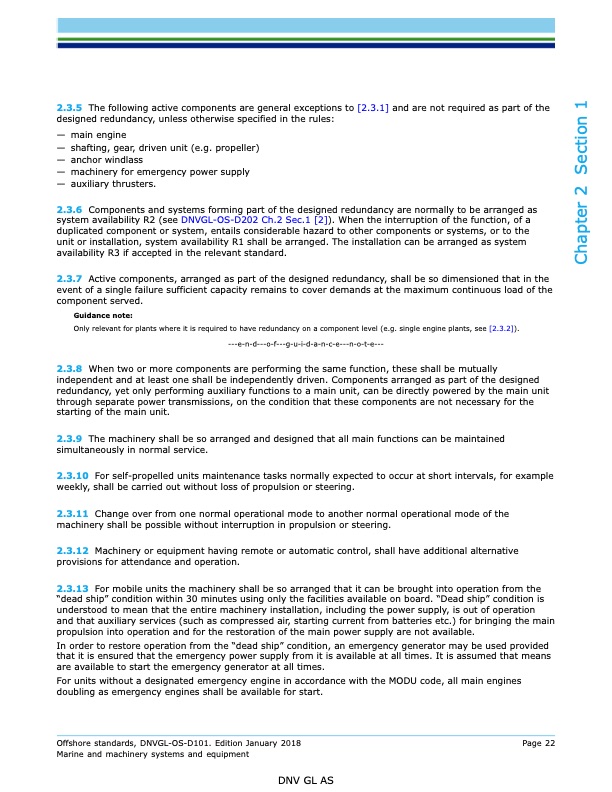
PDF Publication Title:
Text from PDF Page: 022
2.3.5 The following active components are general exceptions to [2.3.1] and are not required as part of the designed redundancy, unless otherwise specified in the rules: — main engine — shafting, gear, driven unit (e.g. propeller) — anchor windlass — machinery for emergency power supply — auxiliary thrusters. 2.3.6 Components and systems forming part of the designed redundancy are normally to be arranged as system availability R2 (see DNVGL-OS-D202 Ch.2 Sec.1 [2]). When the interruption of the function, of a duplicated component or system, entails considerable hazard to other components or systems, or to the unit or installation, system availability R1 shall be arranged. The installation can be arranged as system availability R3 if accepted in the relevant standard. 2.3.7 Active components, arranged as part of the designed redundancy, shall be so dimensioned that in the event of a single failure sufficient capacity remains to cover demands at the maximum continuous load of the component served. Guidance note: Only relevant for plants where it is required to have redundancy on a component level (e.g. single engine plants, see [2.3.2]). ---e-n-d---o-f---g-u-i-d-a-n-c-e---n-o-t-e--- 2.3.8 When two or more components are performing the same function, these shall be mutually independent and at least one shall be independently driven. Components arranged as part of the designed redundancy, yet only performing auxiliary functions to a main unit, can be directly powered by the main unit through separate power transmissions, on the condition that these components are not necessary for the starting of the main unit. 2.3.9 The machinery shall be so arranged and designed that all main functions can be maintained simultaneously in normal service. 2.3.10 For self-propelled units maintenance tasks normally expected to occur at short intervals, for example weekly, shall be carried out without loss of propulsion or steering. 2.3.11 Change over from one normal operational mode to another normal operational mode of the machinery shall be possible without interruption in propulsion or steering. 2.3.12 Machinery or equipment having remote or automatic control, shall have additional alternative provisions for attendance and operation. 2.3.13 For mobile units the machinery shall be so arranged that it can be brought into operation from the “dead ship” condition within 30 minutes using only the facilities available on board. “Dead ship” condition is understood to mean that the entire machinery installation, including the power supply, is out of operation and that auxiliary services (such as compressed air, starting current from batteries etc.) for bringing the main propulsion into operation and for the restoration of the main power supply are not available. In order to restore operation from the “dead ship” condition, an emergency generator may be used provided that it is ensured that the emergency power supply from it is available at all times. It is assumed that means are available to start the emergency generator at all times. For units without a designated emergency engine in accordance with the MODU code, all main engines doubling as emergency engines shall be available for start. Offshore standards, DNVGL-OS-D101. Edition January 2018 Marine and machinery systems and equipment Page 22 DNV GL AS Chapter 2 Section 1PDF Image | Marine and machinery systems and equipment 2018

PDF Search Title:
Marine and machinery systems and equipment 2018Original File Name Searched:
DNVGL-OS-D101.pdfDIY PDF Search: Google It | Yahoo | Bing
Development of a solar powered Electric Ship The Electricship website originally started off as a project to develop a comprehensive renewable, affordable, modular electric ship... More Info
Modular Boat Hull Composite The case for a unsinkable, modular composite hybrid boat hull... More Info
MS Burgenstock Hybrid Electric Catamaran Lake Lucerne Unique shuttle servicing Lucerne to the Burgenstock Resort... More Info
Ground Power Unit GPU Powered by Lithium Ion Batteries The goal of the Ground Power Unit is to provide a readily accessible, modular, ready-to-power solution for remote power... More Info
| CONTACT TEL: 608-238-6001 Email: greg@electricship.com | RSS | AMP |